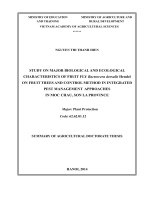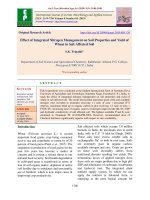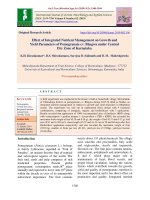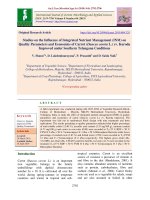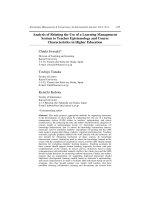Quantification of the role of integrated pest management (IPM) against brown planthopper Nilaparvata Lugens stal. in the upland rainfed rice growing areas of West Bengal, India
Bạn đang xem bản rút gọn của tài liệu. Xem và tải ngay bản đầy đủ của tài liệu tại đây (258.27 KB, 7 trang )
Int.J.Curr.Microbiol.App.Sci (2020) 9(8): 2496-2502
International Journal of Current Microbiology and Applied Sciences
ISSN: 2319-7706 Volume 9 Number 8 (2020)
Journal homepage:
Original Research Article
/>
Quantification of the Role of Integrated Pest Management (IPM) against
Brown Planthopper Nilaparvata lugens Stål. in the Upland Rainfed Rice
Growing Areas of West Bengal, India
Pinaki Acharjee1*, Chitta Ranjan Satpathi1, Sanjit Pramanik2 and Malay Kanti Modak3
1
Department of Agricultural Entomology, 2Department of Soil Water and Conservation,
Bidhan Chandra Krishi Viswavidyalaya, Mohanpur Nadia, West Bengal, 741252, India
3
Dept. of Seed Science and Technology, Institute of Agricultural Science, Calcutta University,
Kolkata, West Bengal, 700019, India
*Corresponding author
ABSTRACT
Keywords
Brown plant
hopper, Rice,
I.P.M, Crop age
Article Info
Accepted:
22 July 2020
Available Online:
10 August 2020
A field trial was conducted to quantify the role of Integrated Pest management
(IPM) against brown planthopper Nilaparvata lugens Stål. in the upland rainfed
rice growing areas of West Bengal, India during 2002-03 and it was reevaluated
during 2017-18. The trail comprised of three treatments viz. (a) Natural Biological
Control (NBC) -with no application of insecticides throughout the crop growth (b)
Schedule based protection (SBP)- application pesticides as per farmers
recommendation (C) IPM Treatment- selected component of management at two
different villages in the district of Bankura and Birbhum. The pooled data from the
corresponding years (2002, 2017 and 2003, 2018) of the seasons indicated that
among the three treatments the Integrated Pest Management system which
included cultivation of resistant variety viz., Chaityanya (MTU-2067), delaying of
planting time up to first week of August, application of fertilizer @ 60:40:40
(N:P:K) with spacing 20x15cm, alternate wetting and drying the field at 80, 87
and 94 DAT, and spraying of Imidachloprid 17.8 SL @ 30 gm a.i. / ha at 75 and
90 DAT could maintain the BPH population below economic threshold level in
upland rainfed rice growing areas of West Bengal.
Introduction
In India, the first IPM programme in rice crop
was started at Cuttack in 1975. As a result of
implementation of a number of cultural
practices and Economic Threshold Level
(ETL) based application of insecticides, the
number of applications was reduced from 3-4
to one (Brader, 1979). Subsequently, an
Operational Research Project (OPR) was
initiated on integrated control of Brown Plant
Hopper (BPH) in other parts of India. This
2496
Int.J.Curr.Microbiol.App.Sci (2020) 9(8): 2496-2502
also led to a reduction in number of sprays
simultaneously increased yields of rice
(Krishnaiah, 1983). Due to problem of
residual toxicity, bio accumulation and
biomagnifications
of
toxic
residues,
increasing
tolerance,
disturbances
in
ecosystem, prohibitive costs in chemical
method, increasing emphasis has been given
on IPM approaches particularly in last two
decades. But adoption of the approach at
farmers level in developing Countries like
India is still far from satisfactory (Kalode and
Krishnaiah, 1991). From the study of the
Incidence of Brown Planthopper (BPH)
Nilaparvata lugens Stål (Delphacidae:
Hemiptera) in relation to the age of rice crop
it was recorded that the 100-140 days old
aged rice plant harbored higher number of
BPH/hill compared to 80-90 days old crop
(Shivshankar et al., 2012). Farmers are mostly
rely on Chemicals pesticides for the
management of rice pest. But the evaluation
of Some Insecticides Against Brown Plant
hopper, Nilaparvata lugens (Stål) in rice
showed that basal application of Fipronil 0.3
G @ 25 kg ha-1 was made once at 25 DAT
followed by Imidachloprid 40+Ethiprole 40%
w/w or Glamore 80 WG @ 100 g a.i. ha-1; at
55 DAT and 65 DAT are effective for
controlling brown plant hopper in Chiplima,
Sambalpur, Odisha, India. It is thus evident
that despite efforts to develop suitable IPM
programmed in the last few years, BPH has
continued to be the major pest in West Bengal
as given in Fig. 1.
Materials and Methods
Field trials were conducted during the kharif
season of 2002 to 03 at two different villages
Viz. Gorabari: district Bankura; and
Gopalpur: district Birbhum. The trail
comprised of three treatment Viz. (a) Natural
Biological Control (NBC) -with no
application of insecticides throughout the crop
growth (b) Schedule based protection (SBP)-
application of Fipronil 0.3 G @25kg a.i./ha at
nursery & transplanted field at 25 DAT,
application of Imidacloprid @30 gm a.i. at 60
to 70 & 80 to 90 DAT. (C) IPM Treatmentselected component of Management Viz.
cultivation of resistant variety Chaityanya
(MTU-2067) in rain fed up land areas
(Gorabari and Kamalpur), delaying of
planting time up to first week of August,
application of fertilizer @ 60:40:40 (N:P:K)
with spacing 20x15cm, alternate wetting and
drying the field at 80,87 and 94 DAT, and
spraying of Imidachloprid 17.8 SL @ 30 gm
a.i. / ha at 75 to 90 DAT with 2 applications
in each village. Each treatment covered an
area of one hectare. Observations were
recorded from 25 selected hills. Yield per
hectare was computed from crop cuts of 5x5m
area. The data were reevaluated after 15 years
at the same location against brown
planthopper during 2017-18.
The pooled data of 2002 and 2017 as well as
2003 and 2018 were subjected to analysis of
variance after suitable transformation. Green
yield and economy of different treatments
were computed.
Results and Discussion
From the pooled data of 2002 and 2017 it is
evident that at 60 DAT the population of BPH
was considerably low in the SBP treatment
for both the sites at Gorabari (0.07 to 0.82 per
hill) as compared to NBC (0.10 to 3.40 per
hill) and IPM treatments (0.10 to 2.22 insects
hill). During both the succeeding years of
study the population was mostly identical.
The pooled data of 2003 and 2018 showed
that it was 0.60 to 0.82, 3.42 to 3.62 and 0.82
to 2.22 hoppers per hill in SBP, NBC and
IPM treatments respectively. In general the
population build up started after 75 DAT.
However, in the IPM treatment the BPH
population (1.72 to 2.52 insects per hill) could
not reach beyond the economic Threshold
2497
Int.J.Curr.Microbiol.App.Sci (2020) 9(8): 2496-2502
level which was significantly lower than the
NBC treatments (2.52 to 8.50 per hill) at
Gorabari (Table 1). The population level
obtained from the analysis of pooled data
during 2003 and 2018 indicated that the IPM
treatment was also significantly lower (1.40 to
1.42 insects per hill) than both NBC (8.42 to
12.21 insects hill) and SBP treatments (1.62
to 3.02 insects per hill) respectively at
Gorabari (Table 2). Although the peak BPH
population at 90 DAT was 32.38 to 95.21 and
4.02 to 35.52 insects per hill in the NBC and
SBP respectively treatments but the
population in the IPM treatment remained
below the Economic thresh hold Level (2.52
to 4.62 insects per hill) at Gorabari during
first season of study. Due to some favorable
weather conditions the population increased
in 2003 and it was observed that pooled data
were higher as compare to first season as
34.42 to 111.21, 4.42 to 50.21 and 4.62 to
5.80 insects / hill in NBC, SBP & IPM
Treatment respectively (Table 2). Although
the population emigrated after 120 DAT, a
significantly lower population was observed
in the IPM treatments during first year of both
the seasons (2002 and 2017) and subsequent
years (2003 and 2018) of study (Table 1&2).
The pooled data of 2002 and 2017 from
another village (Gopalpur) under rain fed
upland areas of West Bengal showed that
there was no significant difference in BPH
population among the treatments at 60 DAT
(Table 3) but the pooled data from the
corresponding years of the seasons, 2003 and
2018 indicated that the population in the IPM
treatment was significantly lower than the
SBP & NBC (Table 4). At 75 DAT significant
differences were observed among the
treatments when the population was 2.52 to
9.12, 0.05 to 0.72 and 2.02 to 2.45 insects per
hill during 2002 and 2017. Whereas it was
7.22 to 9.22, 2.62 to 0.82, 0.52 to 2.32 insects
per hill during 2003 and 2018 in the NBC,
SBP & IPM treatments respectively.
Table.1 Quantification of relative importance of brown plant hopper Nilaparvata lugens Stål. as
influenced by different treatments in Gorabari (Bankura)
Treatment
Pooled data of Kharif 2002 and 2017
Average number of plant hopper Nilaparvara lugens Stål. Per hill at different
DAT
NBC
SBP
IPM
CD5%
S.Em±
60 DAT
Site 1 Site 2
0.10 3.40
(0.77) (1.97)
0.07 0.82
(0.75) (1.14)
0.10 2.22
(0.77) (1.64)
0.3698 0.1279
0.1200 0.0707
75 DAT
Mean Site 1 Site 2 Mean
1.75 2.52
8.50 5.51
(1.5) (1.73) (3.00) (2.45)
0.47 0.52
1.32 0.92
(0.98) (1.00) (1.34) (1.19)
1.16 2.52
1.72 2.12
(1.28) (1.73) (1.48) (1.61)
0.2179 0.2179
0.0707 0.0707
90
Site 1
95.21
(9.78)
32.52
(5.74)
2.52
(1.73)
0.126
0.0701
DAT
Site 2
32.38
(5.73)
4.02
(2.12)
4.62
(2.26)
0.2494
0.0787
Mean
63.79
(8.01)
18.27
(4.33)
3.57
(2.01)
120 DAT
Site 1
Site 2 Mean
12.22
12.32 12.26
(3.57) (3.58) (3.57)
3.14
3.12
3.12
(1.90) (1.90) (1.90)
3.16
3.12
3.14
(1.19) (1.90) (1.90)
0.2516 0.2179
0.0816 0.0707
NBC- Natural Biological Control, SBP –Schedule Based Protection, IPM – Integrated Pest Management
Figures in Parenthesis indicate Square root transformed values
(
)
DAT – Day After Transplanting.
2498
Int.J.Curr.Microbiol.App.Sci (2020) 9(8): 2496-2502
Table.2 Quantification of relative importance of brown plant hopper Nilaparvata lugens StaI. as
influenced by different treatments in Gorabari (Bankura)
Treatme
nt
Pooled data of Kharif 2003 and 2018
Average number of plant hopper Nilaparvara lugens Stål. Per hill at different
DAT
60 DAT
75 DAT
90 DAT
120 DAT
Site 1 Site 2 Mean Site 1 Site 2 Mean Site 1
Site 2
Mean Site 1
Site 2 Mean
3.60
3.42 3.51 12.21 8.42 10.32 111.21 32.42 71.81
75.2
11.80
43.5
(2.20) (1.97) (2.00) (3.56) (2.98) (3.28) (10.56) (5.73) 8.50 (8.70) (3.50) (6.63)
0.60
0.82 0.71
3.02
1.62 2.32
50.21
4.42
27.31 35.44
3.2
19.32
(1.40) (1.14) (1.1) (1.87) (1.45) (1.67) (7.12) (2.21) (5.27) (5.99) (1.92) (4.45)
NBC
SBP
0.82
(1.14)
IPM
2.22 1.52
1.40
1.42 1.41
(1.64) (1.42) (1.37) (1.38) (1.38)
5.80
(2.50)
4.62
(2.26)
5.21
(2.38)
4.60
(2.25)
3.2
(1.92)
CD5%
0.3873 0.2179
0.2179 0.2179
0.2238
0.2178
0.3490 0.2179
S.Em±
0.1257 0.0707
0.0707
0.0726
0.0707
0.113
3.9
(2.09)
0.0707
NBC- Natural Biological Control, SBP –Schedule Based Protection, IPM – Integrated Pest Management
Figures in Parenthesis indicate Square root transformed values (
)
DAT - Day After Transplanting.
Table.3 Quantification of relative importance of brown plant hopper Nilaparvata lugens StaI. as
influenced by different treatments in Gopalpur (Birbhum)
Treatment
NBC
SBP
IPM
CD5%
S.Em±
Pooled data of Kharif 2002 and 2017
Average number of plant hopper Nilaparvara lugens Stål. Per hill at different
DAT
60 DAT
75 DAT
90 DAT
120 DAT
Site 1 Site 2 Mean Site 1 Site 2 Mean Site 1 Site 2 Mean Site 1 Site 2 Mean
0.15 0.32 0.23 2.52
9.12
5.82 238.21 31.42 134.81 12.24 12.22 12.23
(0.80) (0.90) (0.85) (1.73) (3.10) (2.51) (15.45) (5.64) (11.63) (3.56) (3.56) (3.56)
0.05 0.32 0.18 0.05
0.72
0.38 45.54
4.42 24.97 3.9
3.82
3.86
(0.74) (0.90) (0.82) (0.74) (1.10) (0.93) (6.78) (2.21) (5.04) (2.09) (2.07) (2.08)
0.09 0.42 0.21 2.45
2.02
2.23 6.12
4.82 5.47
3.24
3.22
3.23
(0.76) (0.95) (0.84) (1.71) (1.58) (1.65) (2.56) (2.30) (2.44) (1.93) (1.92) (1.93)
NS
NS
0.1784 0.2179
0.2224 0.2181
0.2813 0.2179
0.0579
0.0722 0.0708
0.0913 0.0707
NBC- Natural Biological Control, SBP –Schedule Based Protection, IPM – Integrated Pest Management
Figures in Parenthesis indicate Square root transformed values (
)
DAT - Day After Transplanting.
2499
Int.J.Curr.Microbiol.App.Sci (2020) 9(8): 2496-2502
Table.4 Quantification of relative importance of brown plant hopper Nilaparvata lugens StaI. as
influenced by different treatments in Gopalpur (Birbhum)
Treatment
CD5%
Pooled data of Kharif 2003 and 2018
Average number of plant hopper Nilaparvara lugens Stål. Per hill at different
DAT
60 DAT
75 DAT
90 DAT
Site 1 Site 2 Mean Site 1 Site 2 Mean
Site 1
Site 2
Mean
2.62
3.42
3.02
7.22
9.22
8.22
54.00
10.46
32.23
(1.76) (1.97) (1.87) (2.77) (3.11) (2.95)
(7.38)
(3.26)
(5.72)
1.22
1.02
1.12
2.62
0.82
1.72
16.00
3.47
9.73
(1.31) (1.23) (1.27) (1.76) (1.14) (1.48)
(0.06)
(1.99)
(3.19)
0.32
2.42
1.37
0.52
2.32
1.42
5.80
3.22
4.51
(0.99) (2.21) (1.36) (1.00) (1.67) (1.38)
(2.50)
(1.99)
(2.23)
0.242 0.2179
0.2179 0.2179
0.2182 3.49
S.Em±
0.0787 0.0707
NBC
SBP
IPM
0.0707 0.0707
0.0708
1.29
NBC- Natural Biological Control, SBP –Schedule Based Protection, IPM – Integrated Pest Management
Figures in Parenthesis indicate Square root transformed values (
)
DAT - Day After Transplanting.
Fig.1 (a) Brown plant hopper colony on rice stem and its (b) hopper burn symptom at Gopalpur,
Birbhum during kharif (rainy) 2017
a
b
Despite application of suitable control
measure a substantial level of population was
recorded in the IPM (4.82 to 6.82 insects per
hill) and SBP (4.42 to 45.52 insects per hill)
treatments which were significantly lower
than the NBC treatment (31.42 to
238.21insects per hill) at 90 DAT during the
first phase of 2002 and 2017 (Table 3). The
abrupt increase of BPH in upland areas was
probably due to migration of the hoppers from
the rice crop grown in nearby lowland areas.
The population of BPH was drastically
reduced after 90 DAT at Gopalpur in both
2003 and 2018 but the significant differences
were observed among the treatments in which
10.16 to 54.00, 3.47 to 16.00, 3.22 to 5.88
insects per hill were recorded in NBC, SBP
and IPM respectively (Table 4) with the onset
2500
Int.J.Curr.Microbiol.App.Sci (2020) 9(8): 2496-2502
of winter the BPH emigrated and at most
similar level of population was maintained up
to 120 DAT during first phase of study during
2002 and 2017. Heinrichs et al., (1979)
recorded that the resistant varieties by and
large will combine well with insecticides
developed which may be a viable and
meaningful system of IPM against BPH.
Krishnaih (1983) reported that adoption of
IPM practices brought down the general
equilibrium potential of pest to much below
the economic thresh hold level and thus BPH
became a pest of no significance in the
endemic areas. Josephet et al., (1999)
reported that colossal loss in rice Yield due to
BPH
Outbreak
in
1973
following
indiscriminate pesticides use, but the loss
could be revived through practices of IPM.
Earlier Katti et al., (2001) recorded that low
population of BPH was observed at
Hyderabad during the kharif season of 1997.
Their numbers were lowest in SBP (13.0 to
20.2 insect per 25 hill) Compared to NBP
(17.6 to 41.8 insects per25 hills) and NBC
(24.8 to 30.8 per 25 hills) during 60- 75 DAT
Pasalu et al., (2005 also found that the
population of BPH Were Significantly higher
in farmers Practice (F.P) treatment (14.7
insect per hill) as compared to tae IPM (2.8
insect per hills) and scheduled treatment
(S.B.P) (3.4 insect per hills) in rainfall rice
growing area of west Bengal. Seni and Naik
2017 efficacy of Imidachloprid 40+Ethiprole
40% w/w against plant hoppers in both
seasons, as it is recorded second highest mean
percent reduction of hoppers over control.
Ram 2010 also did some work on
identification of new genes for brown plant
hopper resistance in rice introgressed from O.
glaberrima and O. minuta. Shivshankar 2012
studied the Incidence of brown planthopper
(BPH) Nilaparvata lugens Stal. (Delphacidae:
Hemiptera) in relation to age of the rice crop
in Cauvery Command Area of Karnataka,
India and recorded that the 100-140 days old
aged rice plant harbored higher number of
BPH/hill compared to 80-90 days old crop
Summary and conclusion are as follows:
From this study it is emerged out that among
the three treatments the Integrated Pest
Management
system
which
included
cultivation of resistant variety viz.,
Chaityanya (MTU-2067), delaying of planting
time up to first week of August, application of
fertilizer @ 60:40:40 (N:P:K) with spacing
20x15cm, alternate wetting and drying the
field at 80,87 and 94 DAT, and spraying of
Imidachloprid 17.8 SL @ 30 gm a.i. / ha at 75
and 90 DAT could maintain the BPH
population below economic threshold level in
upland rain fed rice growing areas of West
Bengal.
References
Brader, L. 1979 Integrated Pest control intac
developing world. A. Rev. Ent., 24:
225-254.
Heinrichs, E.A., Saxena, R.C., and Chelliah,
S.
1979.
Development
and
Implementation of insect Pest
Management System for rice in
tropical Asia. In: Sensible Use of
Pesticides FFTC Ser No. 14. ASPAC,
Taiwan pp, 208-249.
Joseph, D., Krishnakumari, Amma, Nair, K.,
Girija, D., and Thomas, B., 1999,
Operational Research Project on
Integrated Control of rice Pests in
Kuttanad Five Decades of Rice
Research.
Kerala
Agricultural
University. 81-88.
Kalode, M.B and Krichraich, K. 1991,
International Pest Management in
Rice. Indian J. Plant Prot 19:117-132.
Katti, Gururaj, Pasalu, I.C, Varma, N.R.G and
Dhanda Pani, N. 2001. Quantification
of Natural Biological Control in rice
ecosystem for possible exploitation in
rice IPM. Indian J. Ent 63(4):439-448.
2501
Int.J.Curr.Microbiol.App.Sci (2020) 9(8): 2496-2502
Krishnaial, K. 1983. Integrated pest
management in rice, paper Presented
in rice workshop. Hyderabad, April, 912, 1983.
Pasalu I.C; Katti Gururaj, Dari, R. C; Bora,
D.K., Singl, M.P, Satpathi, C. R;
Reddy, P.S; Rao, C.G.S.N and
Vemkateshwarlu, 2004-2005. DRR
Technical Bulletn No.10. Pp. 47.
Ram, T., Deen, R, Gautam, S.K., Ramesh, K.
Rao, Y.K and D. S. Brar, D.S. 2010
Identification of new genes for brown
plant hopper resistance in rice
introgressed from O. glaberrima and
O. minuta. Rice Genetics News Letter,
vol. 25, pp. 67-69
Seni, A. and Naik, V. 2017. Evaluation of
Some Insecticides Against Brown
Plant hopper, Nilaparvata lugens
(Stål) in Rice, Oryza sativa L.
International Journal of Bio-resource
and Stress Management 8(2): 268-271
Shivshankar, P., Chandrashekharaiah, T,
Naveena, N.L and Mallikarjun 2012.
Incidence of Brown Planthopper
(BPH) Nilaparvata lugens Stål
(Delphacidae: Hemiptera) in relation
to the age of the rice crop. Int. J. Ag.
Sc. Vol III. Pp. 197-200.
How to cite this article:
Pinaki Acharjee, Chitta Ranjan Satpathi, Sanjit Pramanik and Malay Kanti Modak. 2020.
Quantification of the Role of Integrated Pest Management (IPM) against Brown Planthopper
Nilaparvata lugens Stål. in the Upland Rainfed Rice Growing Areas of West Bengal, India.
Int.J.Curr.Microbiol.App.Sci. 9(08): 2496-2502. doi: />
2502
